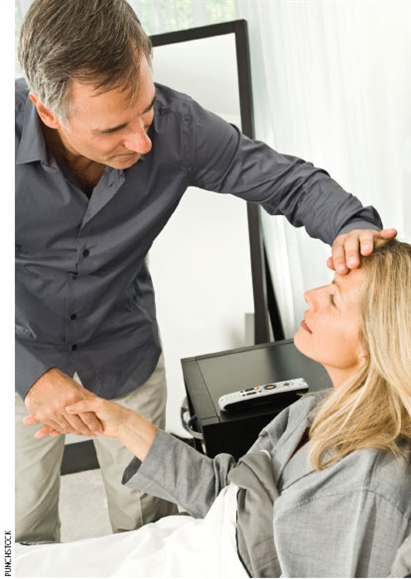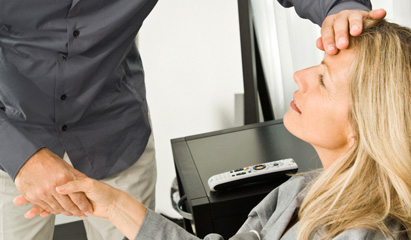With advances in cancer care creating opportunities for more outpatient treatment and changes in health care payment and delivery leading to shorter hospital stays, the responsibility for care of cancer patients is falling increasingly on family members. Without medical training, these family members are now taking on tasks that only hospital staff used to be responsible for. In addition to asking family members to join the patient at doctors’ appointments and to communicate with health care professionals regarding expectations for and possible side effects of treatment, we now must train them to manage equipment and schedules—tasks that they may be ill-prepared to take on.
Nine core caregiving processes reflect the responsibility that family members take on when caring for a cancer patient in the home:
- Monitoring or ensuring that changes in the patient’s condition have been noted
- Interpreting (making sense of what has been observed)
- Participating in decision making
- Taking action or carrying out decisions and instructions
- Providing hands-on care
- Making adjustments or adjusting actions based on the patient’s responses to the actions
- Accessing resources that will be needed to care for the patient
- Working to provide the needed care without taking away the patient’s sense of independence
- Navigating the health care system to provide appropriate care.1
THE NEED FOR EDUCATION
 Although caregiving is never easy for family members, health care professionals must try to make it easier by educating, demonstrating, and providing resources. Some of the tasks that family members may be asked to take on include administering medications (including managing pain), providing oxygen support, caring for wounds, managing Foley catheters, bathing, transferring from bed to chair, and making the home safe for medical supports such as walkers or oxygen equipment.
Although caregiving is never easy for family members, health care professionals must try to make it easier by educating, demonstrating, and providing resources. Some of the tasks that family members may be asked to take on include administering medications (including managing pain), providing oxygen support, caring for wounds, managing Foley catheters, bathing, transferring from bed to chair, and making the home safe for medical supports such as walkers or oxygen equipment.
According to the National Cancer Institute, receiving care at home offers the patient the benefits of remaining with family and friends in familiar surroundings; but in exchange, it requires families to address new issues and cope with all aspects of the patient’s care. A team approach involving the patient, family, physicians, nurses, social workers, physical therapists, and others is essential.2
Over the past quarter-century, significant research into the roles and needs of caregivers has found that what they require first and primarily is education.3 Education allows caregivers (and patients) to understand the disease and the symptoms that will require management, to comprehend treatment options, and to learn to use equipment.4 But understanding how the family functions and what will work in the home also requires the support of home health care professionals who have the time and educational tools to work with patients and family members in the home setting. One helpful handout is A Family Caregiver’s Guide to Hospital Discharge Planning, available online from the National Alliance for Caregiving.5 This resource discusses what the hospital will provide for caregivers and what to expect from the discharge planning process.
Houts and colleagues describe a program based on problem-solving and caregiving that is designed to empower family members and decrease the caregiver stress.6 This program—known as COPE, for Creativity, Optimism, Planning, and Expert information—teaches caregivers how to plan, coordinate, and modify as needed care plans given to them by health care professionals. The COPE model not only provides educational sessions, including handouts to be used by caregivers when in the home, but also examines the problem-solving skills of caregivers and works to bolster those skills as needed. Pasacreta and colleagues incorporated symptom management, skills, and medication management into a three-session educational and support program that increased confidence in participants who attended.7,8 Caregiver perceptions of their own health also increased over time.8
WHAT HAPPENS IN THE REAL WORLD
While both of these models report excellent results for support in the home care environment, is it reasonable to expect that hospitals today can provide the necessary level of education and support? If not, then what is the best practice seen today?
Most health care providers, when preparing patients and families for the transition from hospital to home, recognize the need for home care follow-up. Usually, a multidisciplinary discharge team discusses the needs the patient will have at home and arranges for a consultation before the patient is discharged. During this consultation, family members learn such techniques as wound care, Foley catheter care, or how to walk with a patient utilizing supportive equipment. In other cases, the patient is sent home with educational material that the family will need to review. (Hopefully, the material includes pictures that show the “how” of doing something in addition to explaining “why” it is necessary to do.) Then, when the home care intake nurse arrives in the home, the nurse will review the information again. If toilet risers, walkers, or other adaptive devices are to be used, these are usually delivered by a durable medical equipment company.
A few durable medical equipment companies have drivers who can educate family caregivers on the use of their equipment, but unless the driver is delivering oxygen supplies (most such drivers can educate caregivers), this is unlikely. So what do families do in that case? Again, the responsibility to educate falls to the home care nurse. However, these nurses are not usually scheduled to visit the home on the day of discharge.
ONLINE EDUCATION RESOURCES
A number of Web sites provide excellent educational materials for caregivers (and patients), if they know where to look.
The American Cancer Society’s www.cancer.org has several articles on how to care for a cancer patient at home.9 These articles not only look at how to provide care, they also offer strategies for coping as a caregiver, what to do when the patient nears the end of life, and how to connect with other caregivers for support.
Another useful resource is CancerCare Connect at www.cancercare.org.10 Their material focuses on the psychosocial issues surrounding cancer care at home, including how to handle holidays and special occasions, and how to ask for or agree to assistance from others.
Other Web sites explain the use of devices such as oxygen tanks. One such site, www.dgoh.nhs.uk/home/_public/_servportals/respiratory/oxygen.asp, also provides information on using an oxygen concentrator and the safety requirements for oxygen use—such as the need to avoid smoking and open fires and to post signage to let others know that oxygen is in use.11
One Web site, www.clicsargent.org.uk/Home, deals with the specific needs of children and young people with cancer up to age 24 years.12 Designed to improve the care and support that is delivered to this group outside of the hospital setting, this resource is an excellent one for anyone caring for children and young adults with care. Unfortunately for those living outside of the United Kingdom, the site refers to resources such as children’s’ trusts, which are local partnerships of organizations that provide services for children items and are not available in other countries. In many parts of the United States, however, similar groups can be found. For example, Ronald McDonald House provides housing for families when the children are hospitalized and also offers resource lists and support when the child is home.13 Their Web site, http://rmhc.org/, gives additional information on their available locations and activities.
These and other Web sites offer excellent information, but others are not as good. Family members who are not trained medical professionals will not necessarily know which Web sites are to be trusted, so the health care team must provide appropriate datasheets and resources for the patient and family prior to discharge.
